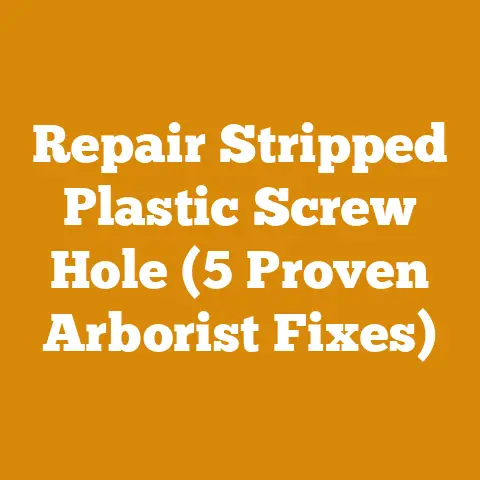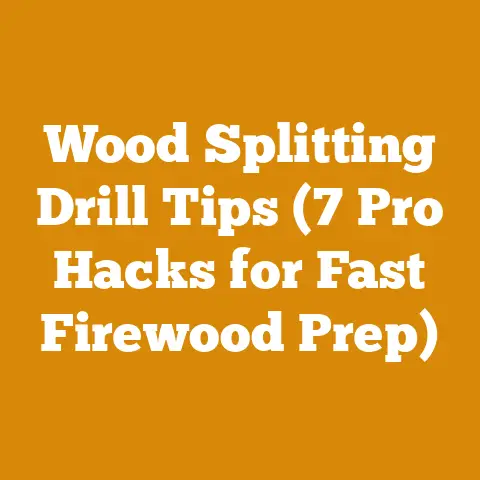Hard Hat for Large Head (5 Must-Know Tips for Arborists)
Introduction: Finding the Perfect Fit – Hard Hats for Arborists with Larger Heads in a Changing Climate
As an arborist, I’ve spent countless hours scaling trees, wrestling with stubborn branches, and processing wood in all kinds of weather. One thing that’s become increasingly clear is the critical importance of having the right gear. But what happens when a standard-sized hard hat just doesn’t cut it? This is where the quest for the perfect hard hat for a larger head begins.
Climate change is also increasingly influencing our work. More frequent and intense storms mean more hazardous conditions in the field. Therefore, ensuring your safety gear, including your hard hat, fits correctly and is up to the task is more crucial than ever.
In this article, I’ll share five must-know tips for arborists with larger heads to find a hard hat that provides optimal protection, comfort, and performance. I’ll delve into the specifics of sizing, suspension systems, materials, and additional features that can make all the difference. Let’s get started.
1. Understanding Head Size and Shape: The Foundation of a Proper Fit
The first step in finding the right hard hat is understanding your head size and shape. It’s not enough to simply assume you need an “extra-large” size. Taking accurate measurements and considering your head’s unique contours is essential.
Measuring Your Head
Grab a flexible measuring tape (the kind used for sewing) and follow these steps:
- Position the Tape: Place the tape around your head, about one inch above your eyebrows and ears. This is generally the widest part of your head.
- Ensure a Snug Fit: Make sure the tape is snug but not too tight. You should be able to comfortably fit a finger between the tape and your head.
- Read the Measurement: Note the measurement in inches or centimeters. This is your head circumference.
Many hard hat manufacturers provide sizing charts based on head circumference. Consult these charts to determine the appropriate size range for your head.
Considering Head Shape
Beyond circumference, head shape also plays a crucial role in hard hat fit. Some people have more oval-shaped heads, while others have rounder heads. A hard hat that’s designed for a different head shape may feel uncomfortable or unstable, even if it’s the correct size according to the sizing chart.
To determine your head shape, try this simple trick:
- Wet Your Hair: Dampen your hair thoroughly.
- Comb Straight Back: Comb your hair straight back away from your forehead.
- Place on Paper: Press your head firmly onto a piece of paper, like you’re making a head print.
- Trace the Outline: Trace the outline of the wet area on the paper.
- Analyze the Shape: Look at the shape you’ve traced. Is it more oval or round?
Knowing your head shape will help you choose a hard hat with a shell design that better matches your natural contours.
My Personal Experience
I have a head size that falls right on the edge between a large and an extra-large. In the past, I’ve purchased hard hats based solely on the circumference measurement, only to find that they felt too tight on the sides or would shift around during climbs. It wasn’t until I started paying attention to the shape of the hard hat shell that I found a truly comfortable and secure fit. Now, I always look for hard hats with a more oval shape, which conforms better to my head.
2. Exploring Suspension Systems: The Key to Comfort and Stability
The suspension system is the network of straps and padding inside the hard hat that cradles your head and absorbs impact. A well-designed suspension system can significantly improve comfort and stability, especially for those with larger heads.
Types of Suspension Systems
There are several types of suspension systems available, each with its own advantages and disadvantages:
- Ratchet Suspension: This is the most common type of suspension system. It uses a ratchet knob to adjust the headband size, providing a precise and secure fit.
- Pinlock Suspension: This system uses a series of pins or holes to adjust the headband size. While it’s less precise than a ratchet system, it’s often more durable and cost-effective.
- Fas-Trac Suspension: This system combines features of both ratchet and pinlock systems. It uses a ratchet knob for fine-tuning, but also incorporates a series of slots for more general size adjustments.
- 4-Point vs. 6-Point Suspension: The number of points refers to the number of straps that connect the suspension system to the hard hat shell. A 6-point suspension system typically provides a more secure and stable fit than a 4-point system, especially for larger heads.
Suspension System Features to Consider
When choosing a suspension system, keep the following features in mind:
- Adjustability: Look for a system that offers a wide range of adjustability to accommodate your head size and shape. A ratchet system with a large adjustment range is often the best choice.
- Padding: Padding is essential for comfort, especially during long days in the field. Look for a suspension system with ample padding on the headband and crown. Some hard hats also offer replaceable padding, which can extend the life of the suspension system.
- Moisture-Wicking: Sweat can quickly become a problem, especially in hot and humid climates. Choose a suspension system with moisture-wicking properties to keep your head dry and comfortable.
- Vertical Adjustment: Some suspension systems allow you to adjust the height of the headband, which can further improve comfort and stability. This is particularly useful if you have a deeper or shallower head shape.
Case Study: The Difference a Suspension System Makes
I once worked on a tree removal project with a colleague who had a similar head size to mine. He was using a basic hard hat with a pinlock suspension system and minimal padding. By the end of the day, he was complaining of headaches and neck pain. I let him try my hard hat, which had a ratchet suspension system with ample padding and moisture-wicking properties. He was amazed at the difference in comfort and stability. The next day, he went out and bought a similar hard hat, and his headaches disappeared. This experience really highlighted the importance of investing in a high-quality suspension system.
3. Material Matters: Balancing Protection, Weight, and Ventilation
The material of the hard hat shell plays a crucial role in its ability to protect your head from impact. It also affects the weight, ventilation, and overall comfort of the hard hat.
Types of Hard Hat Materials
The most common hard hat materials are:
- High-Density Polyethylene (HDPE): This is the most widely used material for hard hats. It’s lightweight, durable, and relatively inexpensive. HDPE hard hats are suitable for a wide range of applications.
- Acrylonitrile Butadiene Styrene (ABS): ABS is a stronger and more impact-resistant material than HDPE. It’s also more resistant to chemicals and extreme temperatures. ABS hard hats are often preferred for more demanding work environments.
- Polycarbonate: Polycarbonate is an extremely strong and impact-resistant material. It’s also lightweight and offers excellent UV protection. Polycarbonate hard hats are typically more expensive than HDPE or ABS hard hats, but they provide superior protection.
Weight Considerations
The weight of the hard hat can significantly impact comfort, especially during long days of climbing and working. A heavier hard hat can cause neck strain and fatigue. When choosing a hard hat, look for one that balances protection with a reasonable weight.
- HDPE: Generally the lightest option.
- ABS: Slightly heavier than HDPE, but still manageable.
- Polycarbonate: Can be heavier than HDPE and ABS, but the added protection may be worth it for some arborists.
Ventilation
Proper ventilation is essential for keeping your head cool and comfortable, especially in hot and humid climates. Look for a hard hat with vents that allow air to circulate freely. Some hard hats also have adjustable vents that can be opened or closed depending on the weather conditions.
Data Point: Impact Resistance
According to ANSI standards, all hard hats must meet certain impact resistance requirements. However, some materials and designs offer superior protection. For example, a polycarbonate hard hat can typically withstand a higher impact force than an HDPE hard hat.
My Recommendation
For arborists working in demanding environments, I recommend considering an ABS or polycarbonate hard hat. While they may be slightly heavier or more expensive, the added protection and durability are well worth the investment. And don’t forget to prioritize ventilation, especially if you work in a hot climate.
4. Additional Features: Enhancing Functionality and Safety
Beyond the basic requirements of a hard hat, there are several additional features that can enhance functionality and safety for arborists.
Integrated Eye Protection
Many hard hats now come with integrated eye protection, such as retractable face shields or safety glasses. This can be a convenient and cost-effective way to protect your eyes from debris and sunlight. Look for eye protection that meets ANSI Z87.1 standards for impact resistance.
Hearing Protection
Arborists often work in noisy environments, such as near chainsaws or chippers. Hearing protection is essential for preventing hearing loss. Some hard hats come with integrated earmuffs, while others have slots for attaching aftermarket earmuffs.
Headlamp Attachments
Working in low-light conditions is sometimes unavoidable. A headlamp can provide essential illumination for climbing, pruning, and other tasks. Look for a hard hat with clips or slots for attaching a headlamp securely.
Chin Straps
A chin strap is essential for keeping your hard hat securely in place, especially when working at heights or in windy conditions. Look for a chin strap that is adjustable and comfortable to wear. Some chin straps also have a breakaway feature that allows them to release in the event of a fall, reducing the risk of neck injury.
Reflective Markings
Reflective markings can improve visibility in low-light conditions, making you more visible to coworkers and motorists. Look for a hard hat with reflective stripes or panels on the shell.
Specific Climate Adaptations
In regions with extreme heat, hard hats with UV-resistant materials are crucial to prevent degradation. In colder climates, options with insulated liners or compatibility with winter liners can significantly improve comfort and safety.
Story Time: The Importance of a Chin Strap
I once witnessed a near-miss accident that highlighted the importance of a chin strap. A fellow arborist was climbing a tree when a branch broke unexpectedly. He lost his balance and fell a few feet, but his hard hat came off during the fall. Fortunately, he wasn’t seriously injured, but he could have been if his head had hit the ground. From that day on, I’ve always made sure to wear a hard hat with a chin strap, and I encourage all arborists to do the same.
Data Point: Chin Strap Effectiveness
Studies have shown that wearing a chin strap can significantly reduce the risk of hard hat dislodgement during a fall. One study found that chin straps reduced the risk of hard hat loss by up to 80%.
5. Finding the Right Brand and Model: Research, Reviews, and Recommendations
With so many hard hat brands and models on the market, it can be difficult to know where to start. Here are some tips for finding the right hard hat for your needs:
Research Reputable Brands
Start by researching reputable hard hat brands that are known for quality, durability, and safety. Some popular brands among arborists include:
- Petzl: Petzl is a well-known brand in the climbing and arborist industries. They offer a range of hard hats designed specifically for tree work, with features like integrated eye protection, hearing protection, and headlamp attachments.
- Stihl: Stihl is a leading manufacturer of chainsaws and other forestry equipment. They also offer a line of hard hats that are designed to meet the needs of arborists and loggers.
- Husqvarna: Husqvarna is another popular brand among arborists. Their hard hats are known for their durability and comfort.
- MSA: MSA (Mine Safety Appliances) is a global leader in safety equipment. They offer a wide range of hard hats for various industries, including arboriculture.
- Kask: Kask is an Italian company that specializes in high-performance helmets for sports and industrial applications. Their hard hats are known for their stylish designs and advanced safety features.
Read Online Reviews
Before making a purchase, read online reviews from other arborists who have used the hard hat you’re considering. Pay attention to reviews that mention fit, comfort, durability, and any potential issues.
Ask for Recommendations
Ask your colleagues and fellow arborists for recommendations. They can provide valuable insights based on their personal experiences.
Try Before You Buy
If possible, try on the hard hat before you buy it. This will allow you to assess the fit, comfort, and overall feel. If you’re purchasing online, make sure the retailer has a good return policy in case the hard hat doesn’t fit properly.
Don’t Skimp on Quality
A hard hat is an essential piece of safety equipment. Don’t skimp on quality to save a few dollars. Invest in a hard hat that provides optimal protection, comfort, and durability.
Data Point: Hard Hat Lifespan
According to ANSI standards, hard hats should be replaced every five years, or sooner if they are damaged or have been subjected to a significant impact. Regularly inspect your hard hat for cracks, dents, or other signs of wear and tear.
My Go-To Hard Hat
After years of trying different brands and models, my go-to hard hat is the Petzl Vertex. It offers a comfortable and secure fit, excellent ventilation, and a range of useful features, such as integrated eye protection and headlamp attachments. It’s a bit more expensive than some other hard hats, but I believe it’s well worth the investment for the added safety and comfort.
Bonus Tip: Maintaining Your Hard Hat for Longevity
Once you’ve found the perfect hard hat, it’s important to maintain it properly to ensure its longevity and effectiveness.
Cleaning Your Hard Hat
Clean your hard hat regularly with mild soap and water. Avoid using harsh chemicals or solvents, as they can damage the shell and suspension system.
Storing Your Hard Hat
Store your hard hat in a cool, dry place away from direct sunlight. Exposure to sunlight can cause the shell to become brittle and degrade over time.
Inspecting Your Hard Hat
Inspect your hard hat regularly for cracks, dents, or other signs of wear and tear. Replace the hard hat immediately if you notice any damage.
Replacing the Suspension System
The suspension system is often the first part of the hard hat to wear out. Replace the suspension system every year, or sooner if it becomes damaged or uncomfortable.
My Personal Touch: Customizing for Comfort
I’ve found that adding a thin, sweat-absorbing headband liner to my hard hat significantly improves comfort, especially during hot summer months. These liners are inexpensive and can be easily replaced as needed.
Conclusion: Prioritizing Safety and Comfort for Arborists with Larger Heads
Finding the right hard hat for a larger head requires careful consideration of head size, shape, suspension systems, materials, and additional features. By following the five must-know tips outlined in this article, arborists can find a hard hat that provides optimal protection, comfort, and performance.
Remember, a hard hat is more than just a piece of equipment; it’s your first line of defense against head injuries. Invest in a high-quality hard hat that fits properly and meets your specific needs. Your safety is worth it.
Key Takeaways:
- Measure your head accurately and consider your head shape when choosing a hard hat.
- Prioritize a suspension system that offers a wide range of adjustability, ample padding, and moisture-wicking properties.
- Choose a hard hat material that balances protection, weight, and ventilation.
- Consider additional features like integrated eye protection, hearing protection, and headlamp attachments.
- Research reputable brands, read online reviews, and ask for recommendations before making a purchase.
- Maintain your hard hat properly to ensure its longevity and effectiveness.
Next Steps:
- Measure your head circumference and determine your head shape.
- Research different hard hat brands and models that are known for fitting larger heads.
- Read online reviews from other arborists with similar head sizes.
- Try on several hard hats to assess the fit, comfort, and overall feel.
- Invest in a high-quality hard hat that meets your specific needs and budget.
- Wear your hard hat consistently whenever you’re working in a hazardous environment.
- Regularly inspect and maintain your hard hat to ensure its longevity and effectiveness.
By taking these steps, you can ensure that you’re wearing a hard hat that provides optimal protection and comfort, allowing you to focus on your work and stay safe in the field.
As climate patterns continue to shift, being prepared with the right gear for all weather conditions is more important than ever. A well-fitting, climate-appropriate hard hat is a critical component of that preparation.






